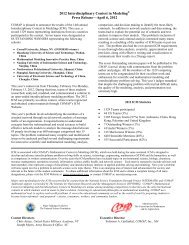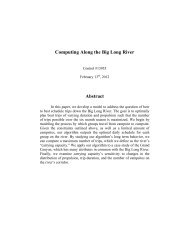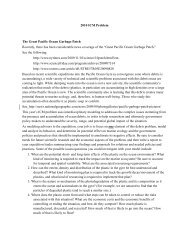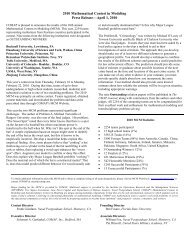Centroids, Clusters and Crime: Anchoring the Geographic Profiles of ...
Centroids, Clusters and Crime: Anchoring the Geographic Profiles of ...
Centroids, Clusters and Crime: Anchoring the Geographic Profiles of ...
You also want an ePaper? Increase the reach of your titles
YUMPU automatically turns print PDFs into web optimized ePapers that Google loves.
Team # 7507 Page 39<br />
attempt to predict <strong>the</strong> location <strong>of</strong> his anchor points instead.<br />
1. Uncertainty in <strong>the</strong> estimate will tend to be smaller for an anchor point predictor. This<br />
is easy to see from <strong>the</strong> inner workings <strong>of</strong> our algorithm. Each method postulates <strong>the</strong><br />
existence <strong>of</strong> an anchor point at <strong>the</strong> centroid <strong>of</strong> a local cluster (or <strong>the</strong> entire dataset), <strong>and</strong><br />
<strong>the</strong>n predicts future crimes based on geographic trends about that anchor. As a result, all<br />
<strong>the</strong> uncertainty in <strong>the</strong> anchor point prediction will contribute also to error in <strong>the</strong> crime<br />
point prediction, <strong>and</strong> on average, <strong>the</strong> total uncertainty will be <strong>the</strong>ir quadrature sum, which<br />
is necessarily greater than or equal to <strong>the</strong> uncertainty in <strong>the</strong> anchor location itself.<br />
2. Anchor point prediction schemes are much more widely researched <strong>and</strong> documented.<br />
Criminologists like Rossmo, Canter, <strong>and</strong> many o<strong>the</strong>rs have studied a broad family <strong>of</strong><br />
anchor point predictors <strong>and</strong> tested <strong>the</strong>m against large sets real-world data from serial<br />
criminals. This allows <strong>the</strong>m to optimize over a wide variety <strong>of</strong> parameters such as distance<br />
functions, decay weightings, temporal weightings, etc. While our model attempts<br />
to compensate by minimizing <strong>the</strong> number <strong>of</strong> such parameters that need to be set <strong>and</strong><br />
choosing <strong>the</strong> o<strong>the</strong>rs based on <strong>the</strong> data being examined, <strong>the</strong> fact remains that its methods<br />
simply have not been validated to <strong>the</strong> same level <strong>of</strong> confidence<br />
3. Real-world considerations <strong>of</strong>ten make an anchor point search more practical. The simple<br />
truth is that, equipped with a prediction <strong>of</strong> likely crime points, <strong>the</strong> best a police force<br />
can hope to do is increase patrol levels <strong>and</strong> o<strong>the</strong>r resources in <strong>the</strong> likely areas, <strong>and</strong> wait<br />
to see if <strong>the</strong> criminal strikes again. On <strong>the</strong> o<strong>the</strong>r h<strong>and</strong>, when given a predicted region for<br />
<strong>the</strong> criminal’s anchor point, <strong>the</strong>y can take a more active approach by searching <strong>the</strong> area<br />
in question for suspicious behavior, eyewitness data, <strong>and</strong> additional evidence. Recall that<br />
at least one <strong>of</strong> <strong>the</strong> anchor points is almost certainly <strong>the</strong> suspect’s home (one study found<br />
this to be true 83% <strong>of</strong> <strong>the</strong> time[15]); <strong>and</strong> consequently, pursuing this anchor point can<br />
give <strong>the</strong> police a sense <strong>of</strong> <strong>the</strong> perpatrator’s home region, provides potential neighbors<br />
who can be interviewed, <strong>and</strong> could even lead to <strong>the</strong> capture <strong>of</strong> <strong>the</strong> criminal in his own<br />
home.<br />
We do not completely eschew <strong>the</strong> utility <strong>of</strong> crime-point prediction: it has <strong>the</strong> obvious benefit <strong>of</strong><br />
potentially saving a life or preventing a rape. Depending on circumstances, it could also be <strong>of</strong><br />
use in predicting <strong>the</strong> body location <strong>of</strong> a missing person presumed to have been taken by a serial<br />
criminal, or even in determining whe<strong>the</strong>r a new crime was committed by <strong>the</strong> same individual<br />
as those in a previous dataset. Once again, we appeal to <strong>the</strong> expertise <strong>of</strong> <strong>the</strong> intuitive cop: when<br />
resources permit or circumstances dem<strong>and</strong>, predicting a future crime point may be a good idea,<br />
but our model itself makes no claims as to whe<strong>the</strong>r this is a good idea in any given case.
















